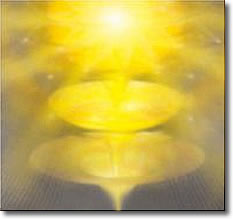We are in a particular moment of this year 6.2 of the Table of the Plan, dedicated to “Space – Infinity. Bases of the New Religion”: on the threshold between its conclusion and the opening of the next annual cycle, we feel that we are in some way challenged by this occasion, and we want to dedicate to this the etymosophical reflection scheduled for today*.
Especially in this moment of assessment and transition, already touched by the reverberation of the flame that animates next year’s Goal, we feel that infinite spirals rise from the thoughts that the current one has inspired us and that we continue to nourish: each of us has understood some of them more clearly and consciously than others, depending on the questions we posed to Heaven and infinite Space, the universal community of all Life, which responded with gifts of understanding, these too always susceptible to be transcended through further ascent.
In the crucible of united group work, these gifts are transmuted to form the treasure of the common chalice to be offered as a contribution to the evolutionary Plan: Thought does not die away in space. Horizontally and vertically thought traverses space. There is no limit to its expansion. But nothing can remain in the same state. We know about the inviolability of thought, but apparently transmutation of it is taking place, and one needs to know into what the thought is being transmuted. It flows into pure fire. A beautiful circle results. From the fire arises energy—a creative thought—and through the earthly furnace this thought is again united with fire. The circle is closed, and renewed energy ascends regenerated for new labor. Such consummated cycles can be observed throughout the Universe. But the evolution of thought will be especially sublime. […] [1]
Let us therefore first delve into the word “gift”, the fruit of that dialogue with Heaven to which the goal for the current year bestows a powerful driving force. Let’s listen to another excerpt from Agni Yoga [2]:
The purification of religions is a necessary condition for a new, direct relationship with the spiritual world.
Christ, the Buddha, and their closest assistants made no use of magical formulas; rather, they acted and created in a way that fully merged with the spirit.
Therefore, in the new evolution the old artificial methods have to be abandoned. Cause and effect. […]
From where does one draw strength and the ability to impart understanding? When we link ourselves with the Great Spirit, recognizing cause and motivation, we set up an immediate consequence. We call on Those who earlier trod the great path of personal awareness and responsibility. And our appeals reach Them, through thousands of raised hands. […] It is spiritual merging that moves mountains. In desiring what is good, we receive the legacy of the Great Beings who bear the Good.
We leave open our spiritual vessel that we might receive the benefit of Their help. […]

The word “gift” is so common and simple as to go unnoticed, but it holds an exceptional flare, since it derives from the Indo-European root *DĀ-, which, according to the linguist Rendich, is composed of the following sound elements: “effect of the action [ā] of light [d]”, “to give”, “to offer”. The verbs of the Sanskrit language – dā –, Greek – didomi – and Latin – dare – that derive from this root all express the idea of offering. The linguist explains that ‘It is the light [d] of the sun that “gives” energy and warmth to life and “offers” nourishment to living beings by regulating their biological rhythms. Hence the use of the consonant d, “light”, to form the Indo-European verb dā “to give”, “to offer”.’ [3]
The flashes of intuition we experience are thus spatial gifts, true rays of light that contribute to the vital exchanges between the Realms and Worlds of infinite space.

Related to the root of offering is also the Sanskrit term indicating religious thought, as Rendich explains: ‘The word dhī, “religious thought”, in which hī is connected to the root hi “to move [h] forward [ī] , or “to set in motion”, reveals the sense of “spiritual activity [hi] of light [d].’ [4]. An important word that can be considered its daughter, in Sanskrit is dhyāna, which indicates “meditation” and which has the exact same root as “faith”, despite appearances.
The idea of gift, thus explored, therefore essentially unfolds the image of the Light lavished by the Hierarchy and the fire of cooperation that, as planetary Disciple/Server, we offer for the development of the Plan.
Let us again recall that the etymon of the word “Disciple” (with which we identify) derives from the Indo-European root *DIŚ-, composed, according to F. Rendich, of three sound elements: “connecting [ś] to the continuous motion [i] of light [d]”.
A passage from Agni Yoga encourages us [5]:
When the cosmic tension is so great, one should gather all strength for the defense of Light […] When the forces are collected around Light, how can one not adhere to the Leading One? Only in this lies strength and victory. […] Thus the thought of Light will be like the Image of the Lord.
Sister to the idea of gift is that of “gratitude”. Again, let us first listen to the words of Agni Yoga [6]:
You think correctly about gratitude. The best expression of gratitude will lie in the realization of the greatness of the Mission. The Service is so great that each step already constitutes an achievement. […]
“Riconoscenza” (Italian for gratitude) derives from “riconoscente”, present participle, which also became an adjective with use, of the verb “riconoscere”, originating from the Latin recognoscere, which meant “reexamine”, “recognise”. In the oldest Italian, the term indicated “awareness”, the re-examination also understood as “repentance”: for example, it is in the latter sense that Dante uses it in the meeting with Beatrice in Purgatory when, on the threshold of Paradise, he regrets having taken his thoughts away from her [7]; as the language evolved, the word took on the prevailing meaning of “gratitude”.
Recognosco is composed of two prefixes and the verb nosco: re indicates iterative action or response, cum indicates union; nosco means “realising”, “noticing” “beginnig to know”. It derives from the Indo-European root *JÑĀ-, in which the following sound components are identified: “the advancing [j] of the cosmic Waters [nā] bearers of knowledge”. Sanskrit jñāna, Greek gnôsis, Latin (g)noscentia, all terms that mean “knowledge”, originate from this etymon. Rendich explains: ‘The Waters, in the course of their inexhaustible journey through the universe, had been able to “know” all created things on earth and in heaven. In the Rg-Veda, the Waters are referred to as viduh pṛthivyā janitram “knowing the origin of heaven and earth”.’ (RV, VII, 34.2).’ [8]
In Indo-European culture, the cosmic Waters were considered “mothers”, the generators of all the “movable and immovable things of creation”. [9] It is a concept extremely akin to that of Space: “gratitude” springs from a renewed awareness of the gifts offered by infinite Space.
 It is an understanding that is renewed – re – continuously through the union – cum – of mind and heart, by which already known and familiar concepts are recognised in a more profound way, becoming luminous intuitions that are experienced for the first time and that open the soul to a powerful, joyful gratitude towards the Above. It is a process of awareness that feeds on the bond with the Hierarchy, similar to the expansion of consciousness: in fact in Sanskrit the word “consciousness” develops from the exact same root, vi-jñāna.
It is an understanding that is renewed – re – continuously through the union – cum – of mind and heart, by which already known and familiar concepts are recognised in a more profound way, becoming luminous intuitions that are experienced for the first time and that open the soul to a powerful, joyful gratitude towards the Above. It is a process of awareness that feeds on the bond with the Hierarchy, similar to the expansion of consciousness: in fact in Sanskrit the word “consciousness” develops from the exact same root, vi-jñāna.
A few more words from Agni Yoga help us further to cherish the idea of Gift and Gratitude:
[…] Know how to feel gratitude as the union of joy and beauty. […] [10]
[…] My path will be your achievement. […] I have no need of thanks, but your gratitude will be fuel to you, because supreme above the flames of other offerings is the fire of gratitude.” […] [11]
________________________________________________________________________
[*] Today, as it happens every three months (more or less), the heliocentric conjunction between Mercury and Neptune occurs, a planetary aspect that is associated with the harmony of language.
[1] Agni Yoga Series, Brotherhood § 378
[2] Agni Yoga Series, Leaves of Morya’s Garden II – Illumination § 114
[3] Franco Rendich, Comparative etymological dictionary of classical Indo-European languages: Indo-European – Sanskrit – Greek – Latin
[4] Ibidem, p. 137
[5] Agni Yoga Series, Hierarchy § 114
[6] Agni Yoga Series, Fiery World II § 465
[7] Purgatorio – XXXI, 85-87
[8] Franco Rendich, Op.Cit., pp. 109-110
[9] Op. cit., p. XXXIX
[10] Agni Yoga Series, Agni Yoga § 98
[11] Ibidem § 83





